Big Questions About the Big Bang
confident explanation of the origin and structure of
the universe falls apart
Look up at the night sky, full of stars and planets. Where did it all come from? These days most scientists will answer that question with some version of the big bang theory. In the beginning, you’ll hear, all matter in the universe was concentrated into a single point at an extremely high temperature, and then it exploded with tremendous force. From an expanding superheated cloud of subatomic particles, atoms gradually formed, then stars, galaxies, planets, and finally life. This litany has now assumed the status of revealed truth. In accounts that deliberately evoke the atmosphere of Genesis, the tale of primal origins is elaborately presented in countless textbooks, paperback popularizations, slick science magazines, and television specials complete with computer-generated effects.
As an exciting, mind grabbing story it certainly works. And because the big bang story does seem to be based on factual observation and calculations a big bang model with irregularities in the distribution of matter on the observed scale must still have a singularity in the beginning.
The Question of Origins
The problem of the singularity is simply part of the larger problem of understanding the origin of the initial condition of the universe, whatever it may have happened to be. If a model of universal origins involves a singularity, that certainly creates severe theoretical difficulties. But even if the singularity can somehow be avoided, we are still confronted with the question of where the universe came from. Hoping to sidestep the whole issue of origins, some scientists have proposed the so-called “infinitely rebounding universe,” a universe that expands, contracts to a singularity, and then again expands and contracts continually through the course of unlimited time. There is no beginning and no end, only an endless cycle. This resolves the problem of the origin of the universe by proposing that there is no origin and that the material universe has always existed.
But there are some serious problems with this model. First of all, no one has ever proposed a satisfactory mechanism for the bouncing. Futhermore, in The First Three Minutes physicist Steven Weinberg points out that with each successive bounce progressive changes must take place in the universe. This indicates that at some point there must be a beginning and not a regress extending over an infinite period of time. And thus again you confront the question of origins.
 Just as an arrow will not hit a target’s center unless accurately aimed, so the big bang model will not yield basic observed features of the universe unless the initial conditions of the universe are carefully adjusted. This raises the question of how the universe came to be “aimed” so precisely.
Just as an arrow will not hit a target’s center unless accurately aimed, so the big bang model will not yield basic observed features of the universe unless the initial conditions of the universe are carefully adjusted. This raises the question of how the universe came to be “aimed” so precisely.
Another creative attempt to escape the necessity of dealing with the question of origins is the time-reverse rebounding universe model proposed by English astrophysicist Paul Davies. The universe would expand with time flowing forward and then collapse to a singularity. During the rebound, time flows backward as the universe expands and collapses again into a singularity, the same singularity from which it began its previous forward cycle. In this model, the past becomes the future, and the future becomes the past, thus making the statement “in the beginning” meaningless. This scenario gives one small indication of the many imaginative schemes the cosmologists have been forced to resort to in order to explain the origin of the universe.
The Inflationary Universe
Quite apart from the question of where the initial condition of the universe comes from, there are other problems troubling modern cosmologists. In order for the standard big bang theory to predict the distribution of matter we observe within the universe, the initial state has to be fine tuned to an incredible degree. The question then arises, how did the initial state get that way? Physicist Alan H. Guth of M.I.T has proposed a version of the big bang model that automatically produces the required fine tunings, doing away with the necessity for artificially introducing them into the equations. Called the inflationary model, it assumes that within a rapidly expanding, superheated region of the universe a tiny section cools off and then begins to expand much more violently, just as supercooled water rapidly expands when it freezes. It is this phase of rapid expansion that resolves some of the difficulties inherent in the standard big bang theories.
But Guth’s version has difficulties of its own. Guth has been forced to fine tune his own equations in order to get them to yield his inflationary universe. Thus he is confronted with the same difficulty his model was supposed to overcome. He had hoped to explain the fine tuning required in the big bang universe, but he requires unexplained tuning of his own. Guth and his collaborator Paul J. Steinhardt admit that in their model “calculations yield reasonable predictions only if the parameters are assigned values in a narrow range. Most theorists (including both of us) regard such fine tuning as implausible.” They go on to express a hope that in the future mathematical theories will be developed that will enable them to give a plausible expression of their model.
This dependence on as yet unrealized future developments highlights another difficulty with Guth’s model. The grand unified theories (GUTs) upon which the inflationary universe is based are completely hypothetical and “have little support from controlled experiments because most of their implications are impossible to measure in the laboratory.” (The grand unified theories are very speculative attempts to tie together some of the basic forces of the universe.)
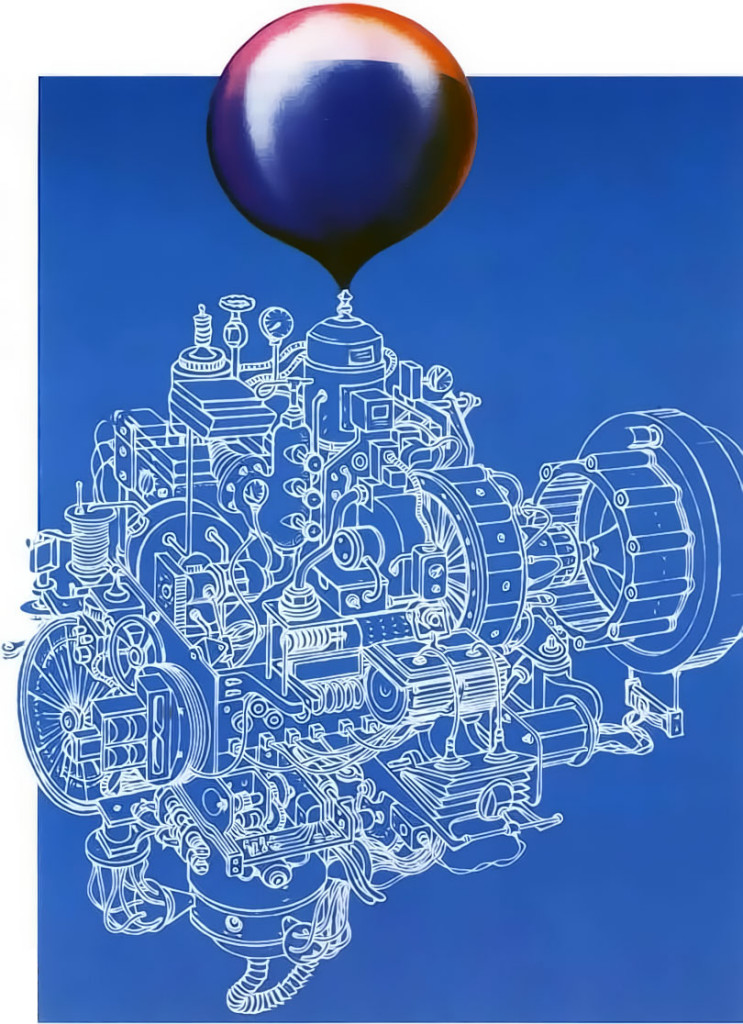 Some cosmologists propose that our complex universe emerged from “literally nothing.” Yet the universe predicted by the big bang theory is little more than a simple bubble of gas, and the “nothing” that produces it is the quantum-mechanical vacuum (here represented by the machine). Far from being “nothing,” the quantum-mechanical vacuum requires chapters of intricate mathematics to be described, even in current incomplete formulations.
Some cosmologists propose that our complex universe emerged from “literally nothing.” Yet the universe predicted by the big bang theory is little more than a simple bubble of gas, and the “nothing” that produces it is the quantum-mechanical vacuum (here represented by the machine). Far from being “nothing,” the quantum-mechanical vacuum requires chapters of intricate mathematics to be described, even in current incomplete formulations.
Another problem with Guth’s theory is that it does not even attempt to explain the origin of the superheated expanding condition necessary for his inflation to take place. He has toyed with three hypothetical origins. The first is the standard big bang-according to Guth the inflationary episode would take place within the very early stages of it. This model, however, leaves us with the knotty singularity problem already discussed. The second option is to assume an initial condition of random chaos, in which some regions would be hot, others cold, some expanding, some contracting. The inflation would begin in an area that was superheated and expanding. But Guth admits there is no explanation for the origin of the imagined primordial random chaos.
The third alternative, favored by Guth himself, is that the superheated expanding region emerges quantum-mechanicallv from nothing. In an article that appeared in 1984 in Scientific American, Guth and Paul J. Steinhardt state, “The inflationary model of the universe provides a possible mechanism by which the observed universe could have evolved from an infinitesimal region. It is then tempting to go one step further and speculate that the entire universe evolved from literally nothing.
As attractive as this idea may seem to scientists who balk at any suggestion of a supreme intelligence that designed the universe, it doesn’t hold up under close examination. The literal “nothing” Guth is speaking of is a hypothetical quantum-mechanical vacuum state occurring in a still-to-be-formulated ultimate grand unified theory combining the equations of both quantum mechanics and general relativity. In other words, this vacuum state cannot now be described, even theoretically.
However, physicists have already come up with a description of a simpler kind of quantum-mechanical vacuum state, which can be visualized as containing a sea of “virtual particles,” atomic fragments that almost but not quite exist. From time to time some of these subatomic particles pop out of the vacuum into material reality.
Such occurrences are called vacuum fluctuations. The fluctuations cannot be directly observed, but theories based upon them have been corroborated by laboratory experiments.
What theoretically occurs is that a particle and antiparticle appear without cause from the vacuum and almost instantaneously negate each other and disappear. Guth and his colleagues postulate that instead of just a tiny particle, the entire universe popped out of the vacuum. And instead of instantaneously disappearing, our universe has somehow persisted for billions of years. The singularity problem is avoided by having the universe pop into being a little bit beyond the stage of singularity.
There are two basic shortcomings in this scenario. First, it involves a truly impressive speculative leap from our limited experience with subatomic particles in the laboratory to the universe as a whole. Stephen Hawking and G.F.R. Ellis sagely warn their colleagues who would without hesitation hurl themselves headlong into such wild speculation. “There is of course a large extrapolation in the assumption that the physical laws one determines in the laboratory should apply to other points of space-time where conditions may be different.” Second, it is actually misleading to speak of the quantum-mechanical vacuum as “literally nothing.” To describe a quantum-mechanical vacuum, even the relatively simple one of currently existing theory, requires chapters upon chapters of highly abstract mathematics. Such an entity is certainly “something.” and this raises the interesting question of where such a complicated “vacuum” might come from.
 Although cosmologists claim to explain the origin of the universe, their models actually yield little more than a uniform cloud of gas. How the variegated structures within the actual universe came into being is still a mystery.
Although cosmologists claim to explain the origin of the universe, their models actually yield little more than a uniform cloud of gas. How the variegated structures within the actual universe came into being is still a mystery.
At this point let us return to the original problem Guth was trying to solve with his inflationary model: trying to eliminate the need for fine tuning the initial conditions in order to obtain the observed universe. As we have seen, he hasn’t succeeded. But another problem is this: does any version of the big bang theory, including Guth’s, really predict the observed universe? What Guth says he finally gets out of his complicated initial state is a universe about 4 inches across, filled with nothing more than a uniform superdense, superheated gas. This will expand and cool, but there is no reason to suppose that it will ever become more than a cloud of uniformly distributed gas. In fact, this is all that any of the big bang theories leave you with. So if Guth’s present theory requires implausible tinkering simply to yield a universe consisting of uniformly distributed gas, then we can just imagine what would be necessary to get it to yield the universe as we know it today. In a good scientific explanation many complex phenomena can be deduced from a simple theoretical scheme, but in Guth’s inflationary universe—-and indeed in the standard big bang theories-—we have just the opposite: from a very complex tangle of equations, we just get an expanding uniform ball of gas. Despite this, science magazines run articles about the inflationary model, complete with pages of high-tech illustrations, that give the impression Guth has finally achieved the ultimate goal—explaining the origin of the universe. Not quite, it seems, perhaps they should run regular columns in the science magazines featuring the universal origin theories of the month.
We can just imagine the complexity of the initial conditions necessary to produce the universe as we know it, with all its varied structures and organisms. In our own universe, these conditions seem to have been arranged far too precisely to be explained simply by physical laws. Thus one could conceivably argue in favor of a designer. At this point some noted theorists, unable even to consider such an idea, take shelter of what they call “the anthropic principle.”
They propose that the quantum-mechanical vacuum is producing universes by the millions. The great majority are not constituted so as to produce life. These universes therefore do not contain observers who could study their conditions. However, other universes, including our own, are constituted so as to have produced observers, and it is therefore not surprising that these observers would discover that their universe possesses some rather startlingly precise conditions to allow for the existence of life. According to this line of reasoning, the observers should not expect to find anything other than such improbably complex conditions. In effect, supporters of the anthropic principle take the very existence of human beings as the explanation of why the universe is so constituted as to have produced human beings But this logical sleight of hand isn’t an explanation of anything.
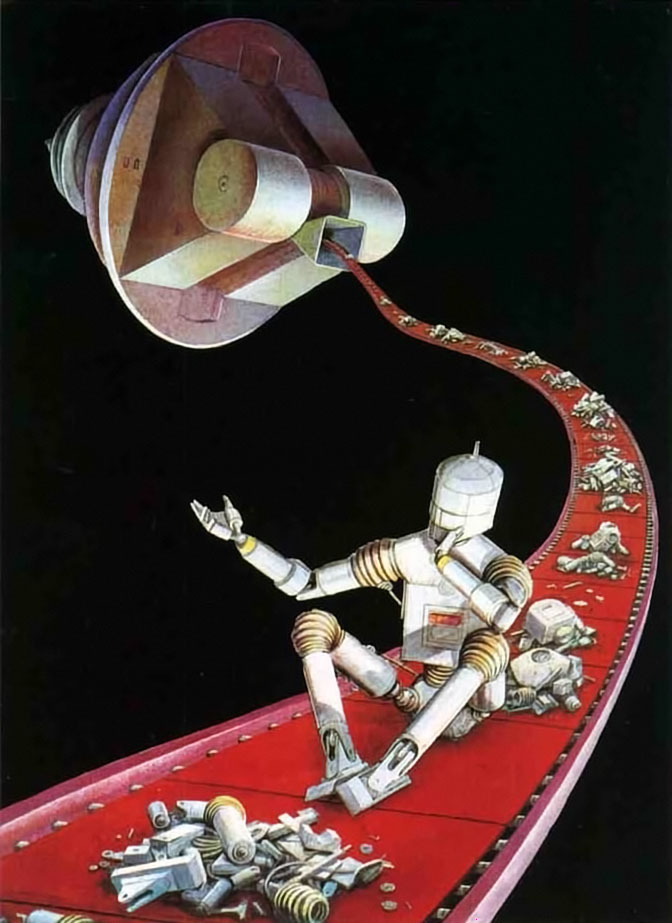 “If I hadn’t been properly constructed, I wouldn’t be here to ask about it.” A sentient robot constructed by a random machine assembler might try to explain its origin in this way. Some scientists suggest that this is how our origin should be explained.
“If I hadn’t been properly constructed, I wouldn’t be here to ask about it.” A sentient robot constructed by a random machine assembler might try to explain its origin in this way. Some scientists suggest that this is how our origin should be explained.
Another form of verbal jugglery is to say straight out, as many scientists do, that the universe has occurred by causeless chance. But it must be pointed out that this also is not at all an explanation. To say that something happens once by chance is in essence no different than simply saying “it happened” or “there it is.” And these statements do not qualify as scientific explanations. In the end you wind up knowing no more than you did before. In other words, by invoking either chance or the anthropic principle the scientists have not actually explained anything about the origin of the universe.
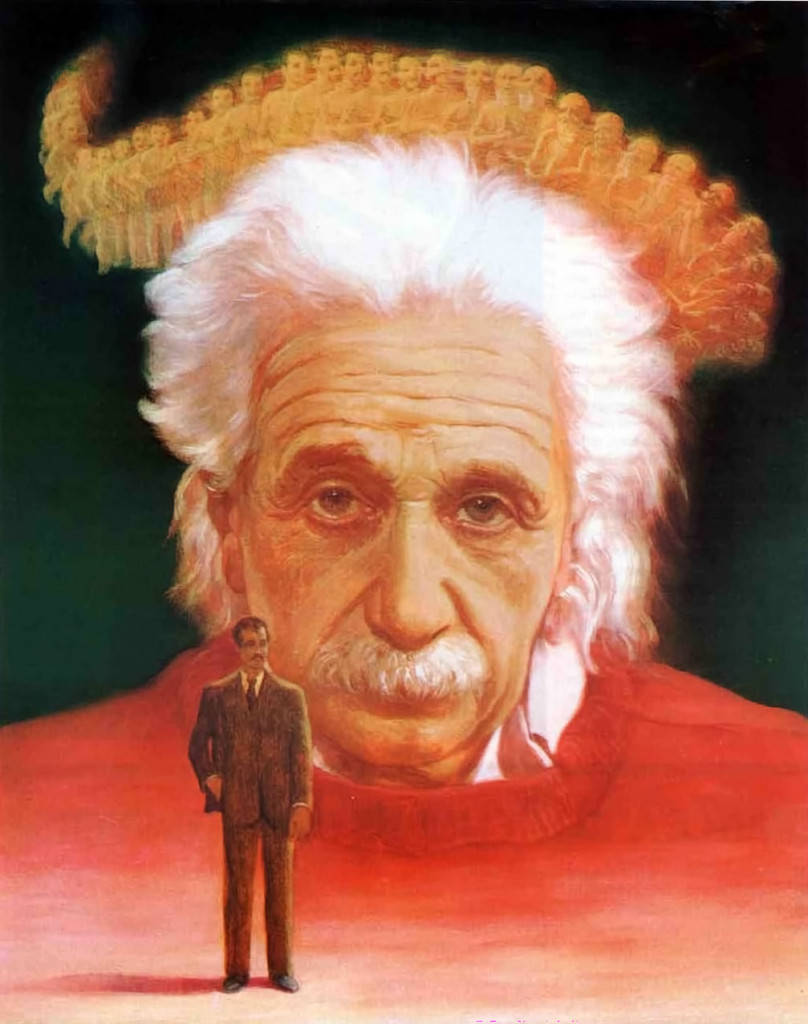 In Einstein’s conception of the universe, a person is not an individual experiencing successive events but a four-dimensional “space-time worm” to which the concept of the passing of time cannot be applied.
In Einstein’s conception of the universe, a person is not an individual experiencing successive events but a four-dimensional “space-time worm” to which the concept of the passing of time cannot be applied.
At this point, the theorists could perhaps forgive us for suggesting that their chosen methods might not be quite adequate for the task at hand. Indeed it appears, in addition to the problems we have already discussed, that general relativity and quantum mechanics, the two intellectual tools with which the cosmologists are attempting to define the development of the universe, contain certain flaws. It is true that these theories have been very successful in describing certain physical phenomena, but this does not prove they are perfect in all respects. General relativity describes curved space-time and is an integral part of every current theory of universal origins, including the big bang theory and Guth’s inflationary model. If general relativity is in need of revision in any way, then any universal theories based on it will also need to be revised.
One major difficulty with general relativity and Einstein’s earlier theory of special relativity is that they rule out time as we commonly understand it. In Newtonian physics, time is treated as a variable separate from space. In this way, it is possible to chart the path of an object moving in space and time in the following way. At a particular point in time, the object is located at a particular point in space. As time varies, the position of the object in space varies. But in Einstein’s theory of relativity, this conception evaporates. Instead, time and space are wedded together in a four-dimensional space-time continuum. It is no longer possible to describe an object as occupying a particular point in space at a particular point in time. A relativistic description of an object will show its spatial and temporal existence in its entirety, merged from beginning to end, wherever it is happening. For instance, a human being would be depicted as the entire progression from embryo to corpse. Such constructs are labeled “space-time worms.” And physics does not permit the space-time worm to say. “Now I am an adult and I used to be a child.” There is no passage of time: the whole sequence exists as one unit. If we are space-time worms, we are just configurations of matter, not personalities with consciousness. Defining human beings in that way invalidates our individual perception of past, present, and future, and thus leads to the conclusion that such perceptions are unreal. In a letter to Michael Besso, Einstein wrote, “You have to accept the idea that subjective time with its emphasis on the now has no objective meaning.” When Besso died, Einstein tried to console his widow by writing, “Michael has preceded me a little in leaving this strange world. This is not important. For us who are convinced physicists, the distinction between past, present, and future is only an illusion, however persistent.” This is in effect a denial of consciousness, which entails the reality of the present experienced moment. We experience our present form as real, whereas our infant form exists only in memory. As conscious beings we can definitely experience that we do occupy a particular bodily form at a particular point in time. Despite the fact that relativity theory converts a series of events into a single unified spatio-temporal entity, we actually experience in sequence different points in time. What all this means is that every theory of universal origins built around relativity theory fails to explain our conscious experience of time, thus making these theories, as they stand, incomplete and unacceptable.
 The strange properties of quantum mechanics have led some scientists to propose that the entire universe splits continuously into multiple copies in which different histories of events take place.
The strange properties of quantum mechanics have led some scientists to propose that the entire universe splits continuously into multiple copies in which different histories of events take place.
Quantum Physics and Reality
All of the current cosmological theories also depend upon quantum mechanics, which defines the activity of atomic and subatomic particles. Quantum physics differs in fundamental ways from classical Newtonian physics. Classical physics concerns itself with the behavior of solid matter, but quantum physics is concerned only with mathematical expressions of observations and measurements. Solid material reality evaporates. Nobel-laureate physicist Werner Heisenberg declared. “It turns out that we can no longer talk of the behavior of the particle apart from the process of observation. In consequence, we are finally led to believe that the laws of nature which we formulate mathematically in quantum theory no longer deal with the particles themselves but with our knowledge of elementary particles.” In addition to the experimental apparatus, the observer had to be brought into the analysis as an explicit clement distinct from the apparatus.
But there are fundamental problems in applying quantum mechanics to the universe. By definition, the universe includes all observers, so you cannot have an outside observer of a universal physical system. In an attempt to formulate a version of quantum mechanics that does not require an outside observer, eminent physicists such as John Wheeler have proposed that the universe continuously splits into innumerable copies. Each parallel universe contains observers to see that particular set of quantum alternatives, and according to this theory all of these universes are real.
Reacting to this. Bryce D. Witt, writing in Physics Today, states. “I still recall the shock I experienced on first encountering the multi-world concept. The idea of 10 to the 100th plus slightly imperfect copies of oneself all constantly splitting into further copies, which ultimately become unrecognizable, is not easy to reconcile with common sense. Here is schizophrenia with a vengeance.” If scientists want a big bang theory of the origin of the universe that can be consistent with quantum mechanics, this is one of the bizarre hypotheses they are forced to come up with.
“The theory of the formation of galaxies is one of the great outstanding problems in astrophysics.”-—Steven Weinberg
But even more problems lie ahead on the path of materialistic reduction that most scientists are treading. It’s bad enough that both general relativity and quantum mechanics lead to bizarre and unrealistic consequences when applied to cosmological questions. But these difficulties are compounded to an exasperating degree by the fact that scientists’ hopes to properly describe the universe and its beginning depend upon combining both theories. The proposed result would be a Grand Unified Theory (GUT) capable of describing all the forces at work in the universe by a single comprehensive mathematical expression. General relativity is required to explain the basic structure of space-time. Quantum mechanics is needed in order to explain the behavior of subatomic particles. Unfortunately these two theories apparently contradict each other. The first step toward this mathematical integration is quantum field theory, which attempts to describe the behavior of electrons by a combination of quantum mechanics and Einstein’s theory of special relativity. This theory has scored some remarkable successes. Yet P.A.M. Dirac, the Nobel-prize-winning English physicist who invented the theory, confessed. “It seems to be quite impossible to put the theory on a sound mathematical basis.” The second and much more difficult step would be to combine general relativity with quantum mechanics, and no one has the faintest idea how to do this. No less an authority than Nobel-laureate physicist Steven Weinberg admits that it may take a century or two to get the mathematics together. The cosmologists say they need the GUT to describe the origin of the universe, and they don’t have it yet. So that can only mean their big bang and inflationary models are without solid foundation. Since the days of Newton and Galileo, the program of physical science has been to express everything in mathematical terms. Furthermore the mathematical description must be confirmed by observation and controlled experiments. We have shown that the big bang theories fail to conform to these requirements. Simplicity has also been stressed as a requirement of physical theories, and the big bang theories also fail in that respect, for they are becoming, as we have seen, progressively more outlandishly contorted with each new formulation. They are just what Galileo and Newton would have disliked—storytelling to fill in the gaps of knowledge.
The big bang theories would therefore appear to be something less than actual scientific explanations of the origin of the universe. Nevertheless, in popular magazines and television specials, as well as in the classroom, scientists deliberately give the public the impression that they have already succeeded in demonstrating exactly how the universe originated simply by physical laws. Nothing could be further from the truth.
What About Galaxies?
We have seen that the cosmologists’ attempt to comprehend the universe within the narrow bounds of their narrow materialistic conceptions has failed to explain its origins. Moreover, we have seen that their theories do not even account for what they say is present in the universe now.
 A cosmic mystery of immense proportions: galaxies may be surrounded by a halo of invisible matter containing up to nine times their visible mass.
A cosmic mystery of immense proportions: galaxies may be surrounded by a halo of invisible matter containing up to nine times their visible mass.
For instance, the big bang theory does not account for the existence of galaxies. Imagine a scientist of great genius who had knowledge of the current cosmological theories but no knowledge of observational astronomy. Would he be able to predict that galaxies would form? The answer is no. A universe made up of a uniformly distributed cloud of gas is the only result consistent with the standard formulations of the theory. This cloud would have a density of perhaps one atom per several cubic feet, making it little better than a perfect vacuum. To get anything else requires special modifications of the initial conditions of the universe, and scientists find such modifications difficult to justify. Traditionally, a scientific theory is considered acceptable if starting from the initial framework you can straightforwardly predict things. A theory that has to be monkeyed around with to a considerable degree to obtain valid predictions is of questionable value.
As Steven Weinberg says in The First Three Minutes, “The theory of the formation of galaxies is one of the great outstanding problems in astrophysics, a problem that today seems far from solution.” Then without skipping a beat he says. “But that is another story.” But no, wait a minute—that is exactly the story! If the big bang theory can’t explain the initial cause of the universe or major features of the universe such as galaxies, then what docs it explain? Not very much, it would seem.
Missing Mass
The big bang theory is supposed to explain the universe, but a major problem is that many features of the universe arc not understood clearly enough to be the subject of such explanation. One big mystery is the problem of missing mass. Physicist David Schramm of the University of Chicago explains, “From all the light being emitted by the Milky Way, we can estimate that our galaxy contains the mass of about one hundred billion suns. But once we take this same object [the Milky Way] and see how it interacts with another galaxy, such as our neighbor Andromeda, we find that our galaxy is gravitating toward Andromeda as though it had a mass almost ten times as great.” It thus appears that over 90% of the mass of the universe is missing. Ghostly subatomic particles called neutrinos have been put forward as the solution. Originally, however, the invisible neutrino was assigned no mass by physicists, but now it has suddenly been assigned mass sufficient to account for the missing matter in the universe as a whole. How convenient.
So even when we leave aside the questions of primal origins and get down to the picture of the universe as it is today, there are still many unanswered questions. The scientists will assert to the public with an air of absolute conviction that they know the universe extends x millions of light years and that it has existed for a total of y billion years. They say that they have identified all the major bodies in the universe for what they are—distant stars, galaxies, nebulae, quasars, and so forth. Yet even the local Milky Way galaxy is not clearly understood.
For example, in Scientific American noted astronomer Bart J. Bok wrote. “I remember the mid 1970s as a time when I and my fellow [Milky Way] watchers were notably self-assured… we did not suspect it would soon be necessary to revise the radius of the Milky Way upward by a factor of three or more and to increase its mass by as much as a factor of 10.” If such basic measurements recently had to be drastically revised after so many decades of observation, then what might the future hold? Will there be even more drastic revisions?
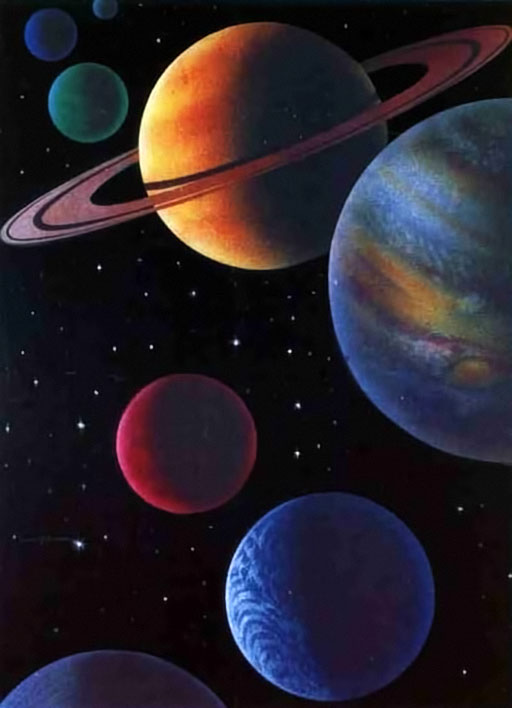 For over a century scientists have held that planets formed from the gravitational contraction of clouds of gas. But they have not been able to show this mathematically or verify it observationally.
For over a century scientists have held that planets formed from the gravitational contraction of clouds of gas. But they have not been able to show this mathematically or verify it observationally.
Even when we get down to our own solar system, we find there are fundamental problems. The traditional account for the origin of planets—that they have condensed from clouds of cosmic dust and gas—is on very shaky ground because the equations for the interactions of the gas clouds have never been satisfactorily solved. William McRae. professor of astronomy at England’s Sussex University and past president of the Royal Astronomical Society, states. “The problem of the origin of the solar system is perhaps the most notable of all unsolved problems in astronomy.”
It should be clear at this point to any impartial onlooker that the strategy of materialistic reduction followed by cosmologists has not allowed them to arrive at firm conclusions about the origin and nature of the universe, despite their public posturing. There is certainly no compelling reason for anyone to insist that the ultimate answers to cosmological questions must be contained in simple mathematically expressed physical laws. Indeed, the quantitative method has proved inadequate for explaining many phenomena very close at hand, what to speak of explaining the vast universe. Therefore it is certainly too early to exclude alternative approaches, approaches that may involve nonphysical explanations—explanations involving principles that go beyond the known laws of physics.
A Different Picture of Reality
There may in fact be nonphysical causes at work in the history of the universe, and there may even be nonphysical regions of the cosmos as well. Physicist David Bohm admits, “The possibility is always open that there may exist an unlimited variety of additional properties, qualities, entities, systems, levels, etc., to which apply correspondingly new kinds of laws of nature.” Thus it is quite possible that as our understanding of natural laws continues to evolve, a picture of reality quite different from the one most people now accept may emerge.
As we have already seen, with infinitely rebounding and infinitely splitting universes, some of the models and concepts proposed by the cosmologists already challenge our commonsense conception of things. Do not think that these strange ideas are out of the mainstream of scientific thought. All the notions we have considered so far are actually the most staid and respectable speculations.
Let us now look at some even more outlandish ideas currently running loose in the world of modern cosmology. Scientist John Gribbin, author of White Holes, a book summarizing these topics, admiringly calls them “the latest series of imaginative leaps made by the creative thinkers today we call scientists—rather than prophets, seers, or oracles.” One is the white hole—a quasar that pours out galaxies in a cosmic gusher. Gribbin says. “Could the white holes actually fragment themselves so that galaxies would reproduce themselves like amoebas. by parthenogenesis? That sounds so unlikely in terms of our everyday experience of the behavior of matter that it’s worth looking at the standard theories of galaxy formation to show just how hopeless they are as explanations of the real Universe. “Fissioning white holes might seem like a solution of last resort, but when no other theory provides any kind of satisfactory solution, that solution is surely the one we must accept.” Another idea seriously entertained by cosmologists is space-time tunnels or “cosmic wormholes.” First seriously discussed in 1962 by physicist John Wheeler in his book Geometrodynamics. the idea has entered into popular consciousness through fantasy movies such as the Star Wars series, where starships hurtle through hyperspace, thus making intergalactic journeys that would normally take millions of years at the speed of light. Some versions of the wormholes sec them as entrances to the past and future, or even to other universes.
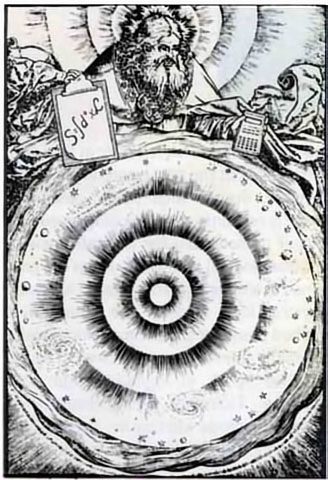 Some theologians try to reconcile religion and science by saying that the universe obeys only the laws of physics and God is the guarantor of those laws. But this compromise makes religion meaningless by depriving God of His omnipotence and leaving Him no active role in the lives of worshipers.
Some theologians try to reconcile religion and science by saying that the universe obeys only the laws of physics and God is the guarantor of those laws. But this compromise makes religion meaningless by depriving God of His omnipotence and leaving Him no active role in the lives of worshipers.
In the early part of this century, Einstein posited a fourth dimension: now, as the implications of his gravitational field equations are being more fully explored, extra dimensions are being added. Paul Davies, a theoretical physicist, writes. “In addition to the three space dimensions and the one time dimension we perceive in daily life, there are seven extra space dimensions that have hitherto gone unnoticed.”
The point of these descriptions is to show that even the material scientists arc being compelled to put forward explanations of the universe that stretch the mind to an incredible degree. But must we stretch our minds only in the directions pointed out by material science? Perhaps minds can be stretched in even other directions. If wc can contemplate higher material dimensions, then why not dimensions of an entirely different sort? There is a definite need for new categories of ideas, ideas that will undoubtedly challenge the currently held reductionists scientific strategy for understanding the universe. That strategy includes the idea that the universe is ultimately simple and can be exhaustively described in terms of quantitative laws.
But suppose this is not so. It certainly appears that the universe is unlimitedly complex and has aspects that may not be approached by quantitative methods. If so, what strategy can be used to gain knowledge about it? The many complex and orderly features of the universe suggest that its cause is an intelligent designer.
This idea brings to mind the following possible strategy. If the underlying cause of the universe is a supreme intelligent being, then there is hope that we can understand the ultimate nature of reality by obtaining information from this being. That there is such a being is certainly a bold proposition, but no more so than the proposal that everything can be explained by simple, mathematically expressed physical laws. And just as in the ease of the quantitative strategy, the value of this alternative strategy can only be judged by how successfully it can be applied. It would be unfair to reject it without seeing how well it can be used to gain practical knowledge about reality.
If we can contemplate higher material dimensions, then why not dimensions of an entirely different sort?
To many the idea of a supreme intelligence will bring to mind the world view of Christian fundamentalism, to which people will have varying reactions. But alternatives to the current theories of cosmologists are not limited to the fundamentalist Christian interpretation of Genesis. Just as there arc many possible materialistic explanations oft he origin of the universe, there are many possible explanations involving a personal creator.
For those seeking to broaden their intellectual options, one very rich source of ideas for understanding the cosmos and our place in it is the Vedic knowledge of ancient India. The Vedas include an extremely sophisticated cosmology. Some of the concepts will be radically different from those now being propagated: others will be surprisingly complementary with current scientific findings. For example. Carl Sagan. while in India filming asegment for his Cosmos television scries, said, “The most sophisticated ancient cosmological ideas come from India. Hinduism [based on the Vedas] is the only religion in which time scales correspond to scientific cosmology.” He noted that the sages of ancient India held that the universe undergoes progressive cycles of creation and destruction over time scales lasting billions of years.
As in modern science, a basic unit of matter is the atom (in Sanskrit, the anu), but the Vedas also include particles of consciousness called jivatmas as well as an integrated superior conscious principle called the paramatma (Supcrsoul). The Supreme Being, seen as the source of a variety of physical and universal energies, is described as a personality simultaneously omnipresent and localized, in whom the universe exists and who exists within every atom of the universe. As we shall see throughout this magazine, such ideas may give a more complete and coherent understanding of the origin and nature of the universe. Consciousness in particular is a fundamental aspect of reality that cannot be ignored in theories that attempt to comprehensively explain the cosmos.
Modern physicists have postulated the existence of various dimensions or levels of reality. The Vedic literatures of ancient India also describe various dimensions or levels of reality, including higher material levels, and still higher levels best described as spiritual or transcendental. These correspond to different levels of conscious perception.
At a time when scientists are proposing such things as multiply-splitting universes, cosmic wormholes for traveling from one space-time region to another, universes in which time reverses, an eleventh dimension of space-time. etc., the ancient transcendental conceptions found in the Vedas should not be dismissed without due consideration. The big bang and inflationary models, which rest on the shakiest of mathematical and theoretical foundations, have certainly failed to provide adequate answers to fundamental questions about the the universe and the galaxies and planets and life forms we find within it today. Perhaps a superconsciousness. a supremely intelligent designer—and not a set of impersonal mathematical equations—is the ultimate explanation for the universe that now seems so inexplicable.

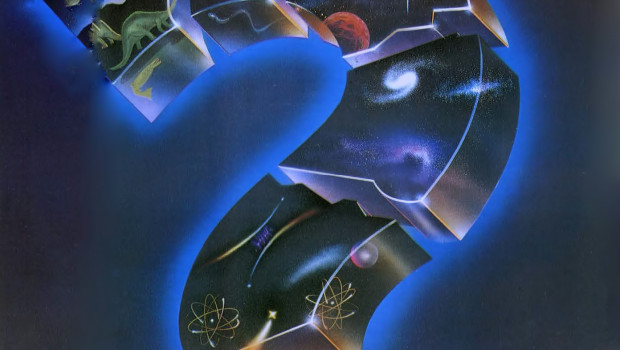
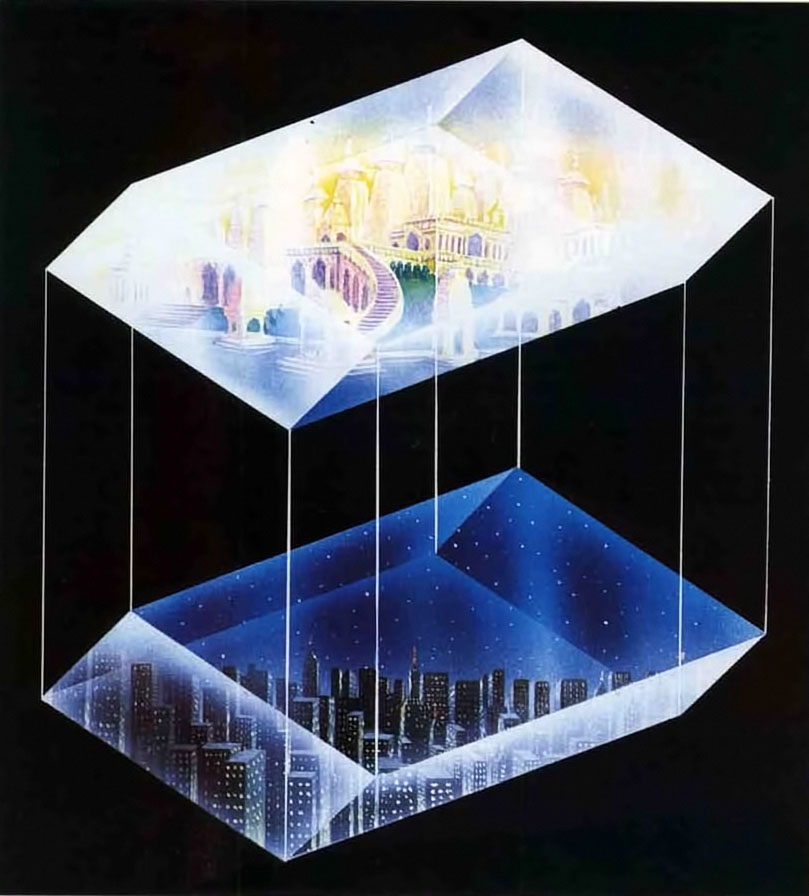
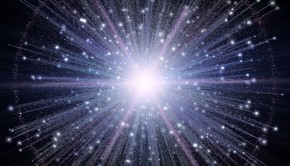
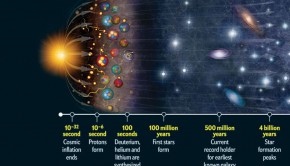
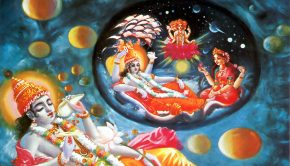
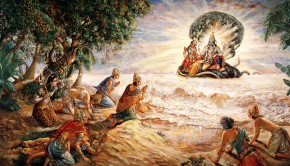









Those Rascal Scientists’ every word is Speculation and Concoctions, they present their Speculation and Concoction to people as Facts, and foolish people also accept these completely false things as Truth. Those Rascal themselves coming from living entities (father and mother) and still they say Life comes from matter. If Life comes from matter so why you (Rascal Scientist) came from your mother and father, why not you came from a rock or a car or a house or any other inanimate object ? Completely Rascal people, these Rascals know one thing very well and that is how to Speculate, how to concoct.